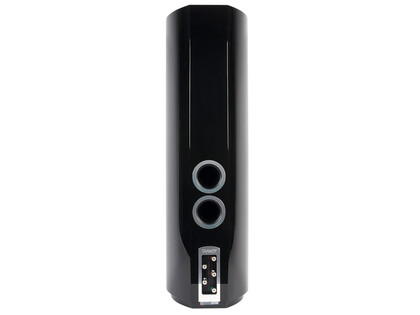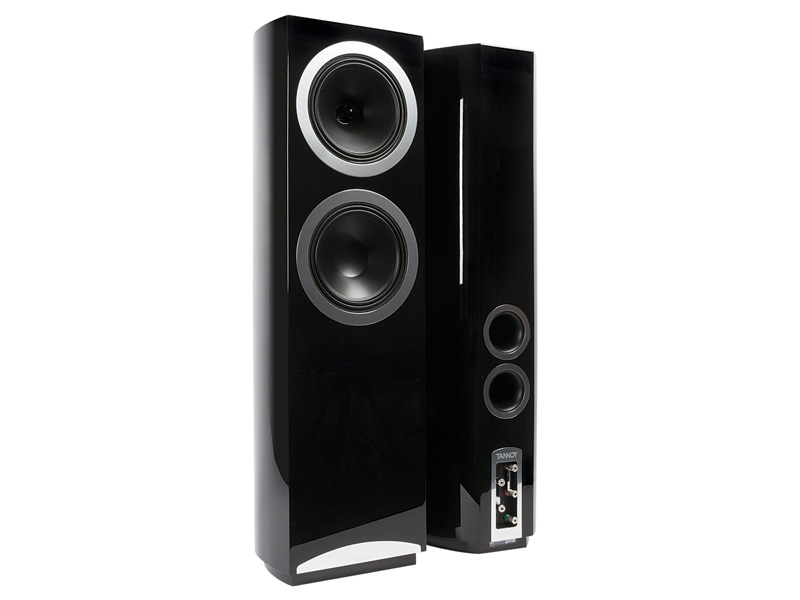TechRadar Verdict
Classy big speaker has massive bass, high sensitivity, real dynamic grip and precise image focus. A real party animal, but midrange has some coloration. A separate plinth would also improve stability
Pros
- +
Classy shape and fine high gloss finish
- +
High sensitivity
- +
Delivers real dynamic expression with plenty of grip and punch
- +
Precisely focused stereo images
Cons
- -
Bass is a bit too strong
- -
Midrange has some coloration
- -
Needs low resistance speaker cables
Why you can trust TechRadar
The Tannoy DC10T is the largest of three Definition series models, which are a very different proposition from the range that carried the same name back in the mid-1990s.
At £5,000 per pair, this is an unquestionably costly loudspeaker, but it's also a very substantial and beautifully built one. The DC10T name translates as follows: the 'DC' bit refers to the Dual Concentric drive unit that does most of the work; the '10' refers to the size (in inches) of both drive units; 'T' is for Tower, the type of speaker we usually refer to as a floorstander.
The DC10T is actually a two-and-a-half-way design, with two 10-inch (254mm) drive units. The Dual concentric driver combines a 180mm paper bass/mid cone with a 25mm hornloaded tweeter that fires through the centre of the cone, so it's effectively a two-way full-range drive unit.
A bass-only drive unit of similar size and construction sits below the DC unit, to ensure plenty of low-frequency output. one interesting detail is that the surrounds of both these drivers are made from heavily doped fabric and formed into a 'double-S' profile.
This rather old-fashioned technique has been coming back into favour recently, as it seems to have less hysteresis than the more common rubber surrounds. Subjectively, this seems to give greater 'speed' at some expense in terms of coloration.
The earlier, more costly Dimension series feature an extra external super tweeter, but the WideBand tweeter used in this Definition model has a 25-micron, titanium dome that extends its frequency response to 35khz. The tweeter horn is the latest version of Tannoy's 'tulip waveguide' and, incidentally, keeps the delicate parts well away from prying fingers and accidental damage.
Other engineering features include a crossover network whose components have received deep cryogenic treatment, while internal wiring is silver-plated, high-purity copper. Twin terminal pairs are fitted for bi-wiring or biamping, plus a fifth terminal that may be used to earth the driver chassis to the amplifier – allegedly reducing RF interference and enhancing dynamic range.

CRYOGENICS: The internal wiring of the DC10T has been cryogenically treated for better conductivity
All this considerable engineering is packaged into a large, very elegantly shaped and beautifully finished enclosure, with notably crisp and clean contemporary lines. Our samples came in a high-gloss black finish, dramatically contrasting with the silver trim around each driver and near the base, but dark walnut and cherry (again high-gloss) are slightly less extreme alternatives.
The relatively large main driver means that this speaker has to be quite wide and also fairly tall (in order to get the tweeter horn up to seated ear-level). Behind the consequently rather imposing front panel, the sides are strongly curved towards a much narrower back, so that reflections and internal horizontal standing waves should be nicely dispersed. Two large ports are also mounted on the narrow rear panel.
The grille is held in place by magnets concealed beneath the front panel surface, which are invisible if the grille is not used. Under the surface, the body is constructed from high-quality plywood, made from dense birch grown in cold regions of the world. The bracing incorporates Tannoy's Differential Material Technology (DMT) techniques to couple the driver/enclosure interface rigidly and with appropriate self-damping.
We have one minor criticism, however, regarding the spike floor-coupling arrangements. Although they are well-handled, the narrow back does compromise stability. A plinth would enhance both appearance and stability, though a rear outrigger would be sufficient to improve the latter.
Sound quality
Ports tuned to a low 28hz, plus two large 254mm bass drivers ensure that the DC10T delivers more than ample low bass, even when sited well clear of the walls in our reasonably large (4.2x2.6x5.5m) listening room. Indeed one can fairly argue that the DC10T delivers rather too much bass below 75hz under our listening conditions, but this doesn't really prove a problem subjectively in practice, because the quality of the bass is mostly very good.
Provided the amplifier and speaker cables are up to the task, it sounds powerful as well as entertainingly agile, albeit with just an occasional hint of chestiness. The caveat is important because the load drops to a very low three ohms at low frequencies, which is really too low for comfort. However, the practical implications are difficult to assess, because the sensitivity across the same bass frequencies is very high indeed, of the order of 95-97dB.
The overall midband sensitivity is pretty generous at around 91-92dB, so even low-power amplifiers should deliver decently high listening levels without distress. The greater worry is the possible influence of the speaker cables, which must be low in resistance (either short, or with a good cross-section of conductor). Although sensitivity is high and the overall balance above 100hz is pretty well-ordered, it's not particularly smooth and the far-field 'power' response shows a quite obvious dip at the mid-to-treble crossover point (1.5khz).
The DC10T might not, therefore, be the most neutral speaker on the block. certainly, voices do sound a bit shut-in, with some 'cupped hands' coloration, but a few minutes playing music quickly makes one realise that those factors are not necessarily the most important ingredients in making music sound interesting, involving – and fun. Indeed, as soon as the speakers are connected up to music sources, their 'fun factor' comes through strongly.
This is an immensely entertaining loudspeaker, thanks to a combination of fine overall coherence and excellent dynamic capabilities. Few speakers can match its ability to define dynamic contrasts and hence convey the musical expression that is an innate part of tight dynamic control.
Most of the listening was carried out using Vertex AQ speaker cables from a Naim NAC552 preamp (NAP500 amplification), fed from a CDS3/555PS CD player, a Linn/ Rega/Soundsmith turntable and a Magnum Dynalab MD103T FM tuner. Additional listening was done with the five-conductor, LFD-sourced Tannoy-branded cable (originally supplied for the Dimension series).
The extra earth wire did seem to offer a modest increase in dynamic range by lowering the noise floor. And a pair of 200/400W MSB M200 Platinum monoblock power amps were added to the mix, which allowed the speakers to be driven to unfeasibly high levels. Their ability to upset the neighbourhood by delivering Leftfield's alternative house album Leftism at full power and with excellent quality was deeply impressive, making this an ideal speaker for those who like to party at home.
The horn-loaded tweeter used by Dual concentric drivers has high inherent efficiency and hence plenty of headroom. While the DC10T's top end sounds clean, sweet, well balanced and nicely integrated, the horn does concentrate the treble output into a 90-degree cone, so the ratio of direct-to-reflected treble sound is lower than with a conventional direct-radiating tweeter.
This, in turn, has significant consequences for the stereo imaging, sharpening the soundstage focus, but somewhat reducing the impression of 'musicians performing in the room'.
This DC10T is not without character and its colorations might, perhaps, be a little too obvious for some tastes. Equally important, however, it supplies an uncommon degree of dynamic grip and drama, which seems more than fair compensation.
Follow TechRadar reviews on Twitter: http://twitter.com/techradarreview
